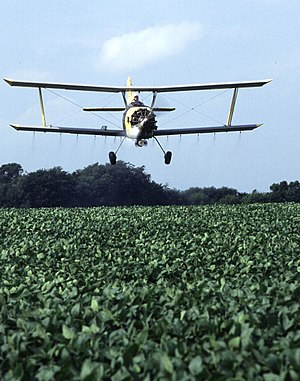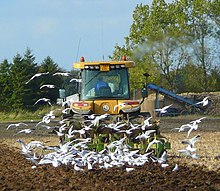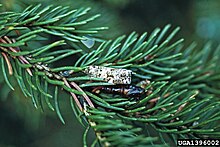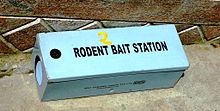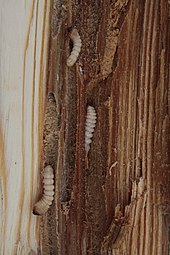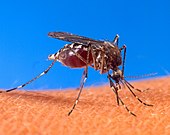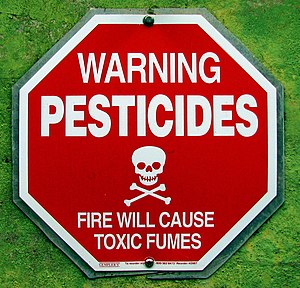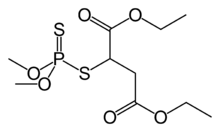A transgene is a gene or genetic material that has been transferred naturally, or by any of a number of genetic engineering techniques from one organism to another. The introduction of a transgene (called "transgenesis") has the potential to change the phenotype of an organism.
In its most precise usage, the term transgene describes a segment of DNA containing a gene sequence that has been isolated from one organism and is introduced into a different organism. This non-native segment of DNA may either retain the ability to produce RNA or protein in the transgenic organism or alter the normal function of the transgenic organism's genetic code. In general, the DNA is incorporated into the organism's germ line. For example, in higher vertebrates this can be accomplished by injecting the foreign DNA into the nucleus of a fertilized ovum. This technique is routinely used to introduce human disease genes or other genes of interest into strains of laboratory mice to study the function or pathology involved with that particular gene.
The construction of a transgene requires the assembly of a few main parts. The transgene must contain a promoter, which is a regulatory sequence that will determine where and when the transgene is active, an exon, a protein coding sequence (usually derived from the cDNA for the protein of interest), and a stop sequence. These are typically combined in a bacterial plasmid and the coding sequences are typically chosen from transgenes with previously known functions.
Transgenic or genetically modified organisms, be they bacteria, viruses or fungi, serve all kinds of research purposes. Transgenic plants, insects, fish and mammals have been bred. Transgenic plants such as corn and soybean have replaced wild strains in agriculture in some countries (e.g. the United States). Transgene escape has been documented for GMO crops since 2001 with persistence and invasiveness. Transgenetic organisms pose ethical questions and may cause biosafety problems.
History
The
idea of shaping an organism to fit a specific need isn't a new science;
selective breeding of animals and plants started before recorded
history. However, until the late 1900s farmers and scientist could breed
new strains of a plant or organism only from closely related species,
because the DNA had to be compatible for offspring to be able to
reproduce another generation.
In the 1970 and 1980s, scientists passed this hurdle by inventing
procedures for combining the DNA of two vastly different species with genetic engineering. The organisms produced by these procedures were termed transgenic. Transgenesis is the same as gene therapy
in the sense that they both transform cells for a specific purpose.
However, they are completely different in their purposes, as gene
therapy aims to cure a defect in cells, and transgenesis seeks to
produce a genetically modified organism by incorporating the specific
transgene into every cell and changing the genome. Transgenesis will therefore change the germ cells, not only the somatic
cells, in order to ensure that the transgenes are passed down to the
offspring when the organisms reproduce. Transgenes alter the genome by
blocking the function of a host gene; they can either replace the host
gene with one that codes for a different protein, or introduce an
additional gene.
The first transgenic organism was created in 1974 when Annie Chang and Stanley Cohen expressed Staphylococcus aureus genes in Escherichia coli. In 1978, yeast cells were the first eukaryotic organisms to undergo gene transfer.
Mouse cells were first transformed in 1979, followed by mouse embryos
in 1980. Most of the very first transmutations were performed by microinjection
of DNA directly into cells. Scientists were able to develop other
methods to perform the transformations, such as incorporating transgenes
into retroviruses
and then infecting cells, using electroinfusion which takes advantage
of an electric current to pass foreign DNA through the cell wall, biolistics which is the procedure of shooting DNA bullets into cells, and also delivering DNA into the egg that has just been fertilized.
The first transgenic animals were only intended for genetic
research to study the specific function of a gene, and by 2003,
thousands of genes had been studied.
Use in plants
A variety of transgenic plants have been designed for agriculture to produce genetically modified crops, such as corn, soybean, rapeseed oil, cotton, rice and more. As of 2012, these GMO crops were planted on 170 million hectares globally.
Golden rice
One example of a transgenic plant species is golden rice. In 1997,[citation needed] five million children developed xerophthalmia, a medical condition caused by vitamin A deficiency, in Southeast Asia alone. Of those children, a quarter million went blind. To combat this, scientists used biolistics to insert the daffodil phytoene synthase gene into Asia indigenous rice cultivars. The daffodil insertion increased the production of ß-carotene. The product was a transgenic rice species rich in vitamin A, called golden rice.
Little is known about the impact of golden rice on xerophthalmia
because anti-GMO campaigns have prevented the full commercial release of
golden rice into agricultural systems in need.
Transgene escape
The
escape of genetically-engineered plant genes via hybridization with
wild relatives was first discussed and examined in Mexico
and Europe in the mid-1990s. There is agreement that escape of
transgenes is inevitable, even "some proof that it is happening". Up until 2008 there were few documented cases.
Corn
Corn sampled in 2000 from the Sierra Juarez, Oaxaca,
Mexico contained a transgenic 35S promoter, while a large sample taken
by a different method from the same region in 2003 and 2004 did not. A
sample from another region from 2002 also did not, but directed samples
taken in 2004 did, suggesting transgene persistence or re-introduction.
A 2009 study found recombinant proteins in 3.1% and 1.8% of samples,
most commonly in southeast Mexico. Seed and grain import from the United
States could explain the frequency and distribution of transgenes in
west-central Mexico, but not in the southeast. Also, 5.0% of corn seed
lots in Mexican corn stocks expressed recombinant proteins despite the
moratorium on GM crops.
Cotton
In 2011, transgenic cotton was found in Mexico among wild cotton, after 15 years of GMO cotton cultivation.
Rapeseed (canola)
Transgenic rapeseed Brassicus napus, hybridized with a native Japanese species Brassica rapa, was found in Japan in 2011 after they had been identified 2006 in Québec, Canada.
They were persistent over a 6-year study period, without herbicide
selection pressure and despite hybridization with the wild form. This
was the first report of the introgression—the stable incorporation of genes from one gene pool into another—of an herbicide resistance transgene from Brassica napus into the wild form gene pool.
Creeping bentgrass
Transgenic creeping bentgrass, engineered to be glyphosate-tolerant
as "one of the first wind-pollinated, perennial, and highly outcrossing
transgenic crops", was planted in 2003 as part of a large (about 160
ha) field trial in central Oregon near Madras, Oregon. In 2004, its pollen was found to have reached wild growing bentgrass populations up to 14 kilometres away. Cross-pollinating Agrostis gigantea was even found at a distance of 21 kilometres. The grower, Scotts Company could not remove all genetically engineered plants, and in 2007, the U.S. Department of Agriculture fined Scotts $500,000 for noncompliance with regulations.
Risk assessment
The long-term monitoring and controlling of a particular transgene has been shown not to be feasible. The European Food Safety Authority published a guidance for risk assessment in 2010.
Use in mice
Genetically modified mice are the most common animal model for transgenic research.
Transgenic mice are currently being used to study a variety of diseases
including cancer, obesity, heart disease, arthritis, anxiety, and
Parkinson’s disease. The two most common types of genetically modified mice are knockout mice and oncomice.
Knockout mice are a type of mouse model that uses transgenic insertion
to disrupt an existing gene’s expression. In order to create knockout
mice, a transgene with the desired sequence is inserted into an isolated
mouse blastocyst using electroporation. Then, homologous recombination
occurs naturally within some cells, replacing the gene of interest with
the designed transgene. Through this process, researchers were able to
demonstrate that a transgene can be integrated into the genome of an
animal, serve a specific function within the cell, and be passed down to
future generations.
Oncomice are another genetically modified mouse species created
by inserting transgenes that increase the animal’s vulnerability to
cancer. Cancer researchers utilize oncomice to study the profiles of
different cancers in order to apply this knowledge to human studies.
Use in Drosophila
Multiple studies have been conducted concerning transgenesis in Drosophila melanogaster,
the fruit fly. This organism has been a helpful genetic model for over
100 years, due to its well-understood developmental pattern. The
transfer of transgenes into the Drosophila genome has been performed using various techniques, including P element, Cre-loxP, and ΦC31 insertion. The most practiced method used thus far to insert transgenes into the Drosophila genome utilizes P elements. The transposable P elements, also known as transposons,
are segments of bacterial DNA that are translocated into the genome,
without the presence of a complementary sequence in the host’s genome. P
elements are administered in pairs of two, which flank the DNA
insertion region of interest. Additionally, P elements often consist of
two plasmid components, one known as the P element transposase and the
other, the P transposon backbone. The transposase plasmid portion
drives the transposition of the P transposon backbone, containing the
transgene of interest and often a marker, between the two terminal sites
of the transposon. Success of this insertion results in the
nonreversible addition of the transgene of interest into the genome.
While this method has been proven effective, the insertion sites of the P
elements are often uncontrollable, resulting in an unfavorable, random
insertion of the transgene into the Drosophila genome.
To improve the location and precision of the transgenic process, an enzyme known as Cre has been introduced. Cre has proven to be a key element in a process known as recombination-mediated cassette exchange (RMCE).
While it has shown to have a lower efficiency of transgenic
transformation than the P element transposases, Cre greatly lessens the
labor-intensive abundance of balancing random P insertions. Cre aids in
the targeted transgenesis of the DNA gene segment of interest, as it
supports the mapping of the transgene insertion sites, known as loxP
sites. These sites, unlike P elements, can be specifically inserted to
flank a chromosomal segment of interest, aiding in targeted
transgenesis. The Cre transposase is important in the catalytic
cleavage of the base pairs present at the carefully positioned loxP
sites, permitting more specific insertions of the transgenic donor
plasmid of interest.
To overcome the limitations and low yields that
transposon-mediated and Cre-loxP transformation methods produce, the
bacteriophage ΦC31
has recently been utilized. Recent breakthrough studies involve the
microinjection of the bacteriophage ΦC31 integrase, which shows improved
transgene insertion of large DNA fragments that are unable to be
transposed by P elements alone. This method involves the recombination
between an attachment (attP) site in the phage
and an attachment site in the bacterial host genome (attB). Compared
to usual P element transgene insertion methods, ΦC31 integrates the
entire transgene vector, including bacterial sequences and antibiotic
resistance genes. Unfortunately, the presence of these additional
insertions has been found to affect the level and reproducibility of
transgene expression.
Future potential
The study of application of transgenes is a rapidly growing area of molecular biology. In fact, it is predicted that in the next two decades, 300 000 lines of transgenic mice will be generated.
Researchers have identified many applications for transgenes,
particularly in the medical field. Scientists are focusing on the use of
transgenes to study the function of the human genome in order to better understand disease, adapting animal organs for transplantation into humans, and the production of pharmaceutical products such as insulin, growth hormone, and blood anti-clotting factors from the milk of transgenic cows.
There are currently five thousand known genetic diseases,
and the potential to treat these diseases using transgenic animals is,
perhaps, one of the most promising applications of transgenes. There is a
potential to use human gene therapy
to replace a mutated gene with an unmutated copy of a transgene in
order to treat the genetic disorder. This can be done through the use of
Cre-Lox or knockout.
Moreover, genetic disorders are being studied through the use of
transgenic mice, pigs, rabbits, and rats. More recently, scientists have
also begun using transgenic goats to study genetic disorders related to
fertility.
Transgenes may soon be used for xenotransplantation from pig
organs. Through the study of xeno-organ rejection, it was found that an
acute rejection of the transplanted organ occurs upon the organ's
contact with blood from the recipient due to the recognition of foreign antibodies on endothelial cells
of the transplanted organ. Scientists have identified the antigen in
pigs that causes this reaction, and therefore are able to transplant the
organ without immediate rejection by removal of the antigen. However,
the antigen begins to be expressed later on, and rejection occurs.
Therefore, further research is being conducted.
Transgenes are being used by manufactures to produce goods such
as milk with high levels of proteins, silk from the milk of goats, and microorganisms that are capable of producing proteins that contain enzymes
that increase the rate of industrial reactions. Agricultural
applications aim to selectively breed animals for particular traits and
animals that are resistant to diseases.
Ethical controversy
Transgene
use in humans is currently fraught with issues. Transformation of genes
into human cells has not been perfected yet. The most famous example of
this involved certain patients developing T-cell leukemia after being
treated for X-linked severe combined immunodeficiency (X-SCID). This was attributed to the close proximity of the inserted gene to the LMO2 promoter, which controls the transcription of the LMO2 proto-oncogene.
In common with most forms of genetic engineering, the use of transgenes
for purposes other than to correct life-threatening genetic
abnormalities is a major bioethical issue.
